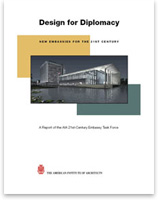User’s Guide: Find a Federal Stimulus Design and Construction Project for Your Firm, Updated
The first stories of the $787 billion American Recovery and Reinvestment Act (ARRA) coming to the aid of architecture firms are starting to trickle in, and it’s hoped that this stream can become a rising tide that lifts increasingly more firms out of the current design and construction market trough. There’s good reason to believe it will. Although some of the funding is being designated for “shovel ready” projects, which may preclude design services, the ARRA is structured to release most of the money applicable to design and construction projects (which the AIA estimates to be $130 billion in total) later in its lifecycle. In 2009, only 12 percent of stimulus package funding will go towards transportation, energy, the environment, and community development projects. In 2012, as the focus of the ARRA shifts to long-term infrastructure development, 63 percent of expenditures will be dedicated to these kinds of initiatives. In line with the AIA Rebuild and Renew government advocacy plan, much of this funding will be applied directly to the built environment as new construction projects, renovations, repairs, and sustainability upgrades. Agency by agency, budget by budget, and (when possible) project by project, this updated guide focuses on money being spent directly by federal agencies and less on cash that must first be filtered through state and local agencies. 
 NGA Adopts AIA Policy of Reaching Carbon Neutrality in Buildings by 2030 NGA Adopts AIA Policy of Reaching Carbon Neutrality in Buildings by 2030
The National Association of Governors (NGA), as part of its comprehensive national Energy Conservation and Improved Energy Efficiency policy, adopted in July the promotion of carbon neutral new and renovated buildings by 2030, a commitment proposed by the AIA. 
WPA 2.0: Enter Your 21st Century Infrastructure Designs
Today has got to be the most exciting time to design sewer treatment plants since the 1930s. Architects’ increasing willingness to apply their design expertise to work-a-day industrial projects, coupled with an economic collapse and the government’s wholesale investment in public infrastructure to fix it, is setting new performance and design expectations for our cities. cityLAB’s WPA 2.0 design competition is meant to capture this energy and channel it into remaking American cities from the ground level—or the subterranean level—up. Its source of inspiration was the original Great Depression-era Works Progress Administration, which largely shaped the urban environments cityLAB now seeks to update. WPA 2.0: Whoever Rules the Sewers Rules the Cities is calling for designs that address the infrastructure needs of our neglected and crumbling cities in the broadest sense: schools, parks, sewers, roads, storm water, solid waste, food production and distribution systems, sustainability, alternative energy generation, smart utilities, fire prevention, etc. 
 AIA Calls on State Department to Integrate Security and Design Excellence AIA Calls on State Department to Integrate Security and Design Excellence
“Design for Diplomacy: New Embassies for the 21st Century,” just released by the AIA, calls on the U.S. Department of State to integrate design excellence with embassy security. The report includes 59 recommendations made by the AIA’s 21st Century Embassy Task Force, chaired by 2009 Kemper Award recipient Barbara A. Nadel, FAIA. 
 Knowledge Leadership Assembly, CACE Come Together in Arizona Knowledge Leadership Assembly, CACE Come Together in Arizona
The AIA Knowledge Leadership Assembly and Council of Architectural Component Executives (CACE) overlapped their annual meetings jointly July 14-18 in Arizona, along with representatives from the AIA College of Fellows, National Associates Committee, and Young Architects Forum. AIA President Marvin J. Malecha, FAIA, told the assembled that the conference was an opportunity for them to better define leadership roles within the Institute as it moves forward. AIA Arizona hosted the annual meeting. 
Volunteering to Help During the Furlough
Members and state and local AIA component colleagues once again graciously stepped forward to serve as points of contact during the national AIA all-staff furlough scheduled August 3–7. During that time, the national component staff will not be available and our offices closed until 8:30 a.m. EDT on Monday, August 10.  |

 NGA Adopts AIA Policy of Reaching Carbon Neutrality in Buildings by 2030
NGA Adopts AIA Policy of Reaching Carbon Neutrality in Buildings by 2030 AIA Calls on State Department to Integrate Security and Design Excellence
AIA Calls on State Department to Integrate Security and Design Excellence Knowledge Leadership Assembly, CACE Come Together in Arizona
Knowledge Leadership Assembly, CACE Come Together in Arizona